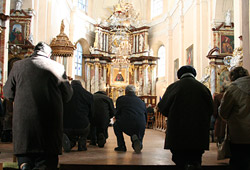Traditions of Piety
Over its 600 years of history, what has most attracted pious souls’ attention at the Trakai Church of the Visitation of the Blessed Virgin Mary is the miraculous image of the Mother of God, renowned for special graces as far back as the 16th century. During an outbreak of the plague in 1603, Bishop Benediktas Vaina (c.1556-1615) is known to have organized a procession to pray before the painting. In 1611, a confraternity of the Rosary was created at the parish. Pilgrimages made by the region’s rulers during the first half of the 17th century are further evidence of the image’s reputation. In 1611, Queen Constance (1588-1631) came to Trakai in the company of the Jesuit priest Peter Skarga (1536-1632) to ask Holy Mary to protect King Sigismund Vasa (1566-1632) on a military campaign to Smolensk. In 1622, the poet Motiejus Kazimieras Sarbievijus (1595–1640) wrote a four-part epic poem about a trip by Governor Jonušas Tiškevičius (1590–1649) from Vilnius to Trakai to pray before Our Lady‘s image and thank her for victory over the Turks at Khotyn in 1621. The papal nuncio sent a communiqué to Rome in 1639 about a trip to Trakai by King Vladislaus Vasa (1595-1648).
Trakai Prepositor Eustachijus Valavičius (1560–1630), a future bishop of Vilnius, had a new altar of the Blessed Virgin Mary installed prior to 1615. Around 1630, Lithuanian Chancellor Leonas Sapiega (1557-1633) donated an exquisite golden crown for the painting. The image’s fame, meanwhile, was spreading throughout all the Grand Duchy. No image of the Mother of God was better known in Lithuania in that period. That is why during the war with Russia from 1655 to 1661 the painting was taken away, hidden, and later transferred to the Chapel of St Casimir at Vilnius Cathedral until 1667. In 1702, during the Great Northern War, the image was again taken to Vilnius for safekeeping at the bishop’s residence.
On September 4, 1718, the Trakai Mother of God image was adorned with golden crowns sent by Pope Clement XI. It thus became the first miraculous image of Our Lady in Lithuania to be officially crowned by the Holy See. Vilnius Bishop Konstantinas Kazimieras Bžostovskis (1644–1722) placed the golden papal crowns on the heads of Mary and Jesus. He hung the rich older crown, knows as the “Vyautas crown”, up above the painting. In his homily, Bishop Bžostovskis stressed that the Trakai Mother of God’s royal diadem designated her as Protectress of Lithuania.
Copies of the Trakai Mother of God icon spread throughout the Grand Duchy of Lithuania. Most were adorned with metallic covers fashioned by local goldsmiths. The oldest copy, which at one point hung above the Trakai Gate in the Vilnius city defence walls, is now kept at St Michael’s Church in Nemenčinė. A famous image of the Trakai Mother of God in Latvia is known as Our Lady of Aglona.
During the Soviet years, public shows of piety to the Trakai Mother of God were less frequent. Still, better educated Catholics, and especially intellectuals from Vilnius, often came to Trakai in order to receive the Sacraments in a shrine that was comparable, in terms of historic national memory, with Vilnius Cathedral, which the communist authorities had closed.
Indulgenced feasts take place each year at the Trakai church on August 15, the Solemnity of the Blessed Virgin Mary’s Assumption into Heaven, and on September 8, the day Mary’s birth is commemorated. These feasts are widely known as “Trakinės” and attract many pilgrims. Pilgrimage traditions, much diminished during Soviet times due to difficulties caused by the authorities, began to flourish once again after Lithuanian regained independence. Many pilgrim groups start their trip on foot after Holy Mass or prayers to the Blessed Virgin at the Dawn Gate in Vilnius. A cross is carried at the head of the processions, hymns are sung and the rosary and litanies are prayed. Almost all the groups stop to pray in Lentvaris at the Church of the Annunciation, which contains relics of St Francis as well as a miraculous image of Our Lady of Perpetual Help. The culmination of the pilgrimages is Holy Mass at the Church of the Visitation in Trakai. By the image of the Trakai Mother of God, Protectress of Lithuania, the Litany of Loreto is usually sung or recited, along with the prayer “We Fly to Your Protection”. It is also customary to pray psalms and parts of the Liturgy of the Hours related to the Blessed Virgin, the Rosary and other devotions.
The Youth Centre of the Vilnius Archdiocese is working to revive and strengthen the tradition of Vilnius-Lentvaris-Trakai youth pilgrimages. Just such a pilgrimage launched the Archdiocesan Youth Day on September 9, 2006. And now every year young people go in groups, bearing colourful banners, singing hymns, cheerfully greeting everyone they pass and giving witness to their living faith. Cardinal Audrys Juozas Bačkis, the Archbishop of Vilnius, has joined the young pilgrims. During the journey, priests and members of religious orders lead catechesis sessions in the various groups about the meaning of pilgrimages, faith, community and vocation.
Trakai is almost always included in the itinerary of pilgrims from afar, and of those who come from neighbouring countries to visit the Gate of Dawn shrine in Vilnius.








